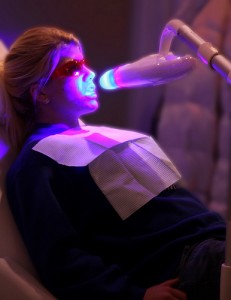Brighter teeth now are getting center stage in cosmetic dentistry. Most frequent reason patients seek for this dental care is discolored anterior teeth. Patients with normal teeth shades also do sometimes request for whitening treatments. Treatment options of discolored teeth include:
- Removal of surface stains
- Bleaching
- Microabrasions and/or macroabrasions
- Veneer
- Porcelain crown
Teeth whitening or bleaching treatments are defined as lightening of the color of a tooth through application of chemicals to minimize the pigmentation of the tooth surface. Most bleaching technique uses derivatives or some form of hydrogen peroxide. They may differ only in concentrations and techniques of application. The chemistry behind teeth whitening is not fully understood but the basic concept of using hydrogen peroxide is considered to be oxidation of organic pigments on the tooth structure such as the enamel and/or dentine.
TYPES OF WHITENING PROCEDURES
Bleaching techniques can be classified as to whether they involve vital or non-vital tooth and whether the procedure is done in the office or outside the office (dentist-prescribed, home-applied technique).
VITAL WHITENING PROCEDURES
Different vital bleaching is mostly dependent upon patients’ preference, cost, compliance and severity of the discoloration. Indications of vital bleaching are:
- Intrinsic discoloration due to trauma, aging or drugs (especially tetracycline and excess fluoride)
- Extrinsic discoloration; in young patient can be any color due to poor oral hygiene, previous restorations, plaque accumulation, presence of chromogenic bacteria, etc; in older patient, color of discoloration usually are brown black or gray. This can be caused by coffee/tea staining, medications, tobacco, restorations and other chromogenic factors.
Vital whitening techniques include in-office and at-home bleaching (also known as nightguard vital bleaching)
IN-OFFICE VITAL BLEACHING

In office professional teeth whitening
Most available bleaching agents are for in-office usage. Most consists of paste or gel compositions that most commonly contain 30% to 35% of hydrogen peroxide. The dentists will place the hydrogen-peroxide containing paste or gel on the teeth and patient is required to note any sensations of discomfort which might be an indication of terminating the treatment. PAC lights and high output halogen light may sometimes be used to accelerate the oxidation reaction by generating heat. On completion of treatment, dentist rinses the teeth and must always caution the patient about postoperative sensitivity.
Bleaching treatment generally are rendered weekly for two to six treatments depending on severity with which each treatment lasting up to 30 to 45 minutes. Patient may experience transient sensitivity but no long-term adverse effect has been reported in the literature to date when bleaching teeth with otherwise healthy pulps.
HOME-APPLIED BLEACHING
Is also known as nightguard vital bleaching is much less labor intensive and requires much less in-office time. The dentist will construct a clear plastic nightguard which can be properly seated and positioned in the mouth.
10 percent to 15 percent carbamide peroxide bleaching material is recommended for this bleaching technique. It is available as white pastes or clear gel. Patient is instructed to apply a thin layer of the bleaching paste into the nightguard and placed on the tooth. The clinician has to review proper insertion of the nightguard to ensure no other soft tissues are damage during this procedure. Most patients prefer an overnight treatment because of the convenience. Nightguard is worn at night and will be removed in the morning. The bleaching time and frequency can be accommodated according to patient’s comfort level under clinician’s supervision. If side-effect experienced while undergoing treatment i.e. sensitive teeth or irritated gums, patient should reduce or discontinue treatment immediately and must contact the dentist to determine and eliminate the problem. Modification of treatment can be done if patient still wants to continue treatment.
IMPORTANT REMINDER
No one bleaching technique is effective in every situation and all success is not equal

![Reblog this post [with Zemanta]](http://img.zemanta.com/reblog_e.png?x-id=ce097b35-0477-4479-885a-24e71f5cadee)
Pingback: Laser Teeth Whitening | Intelligent Dental